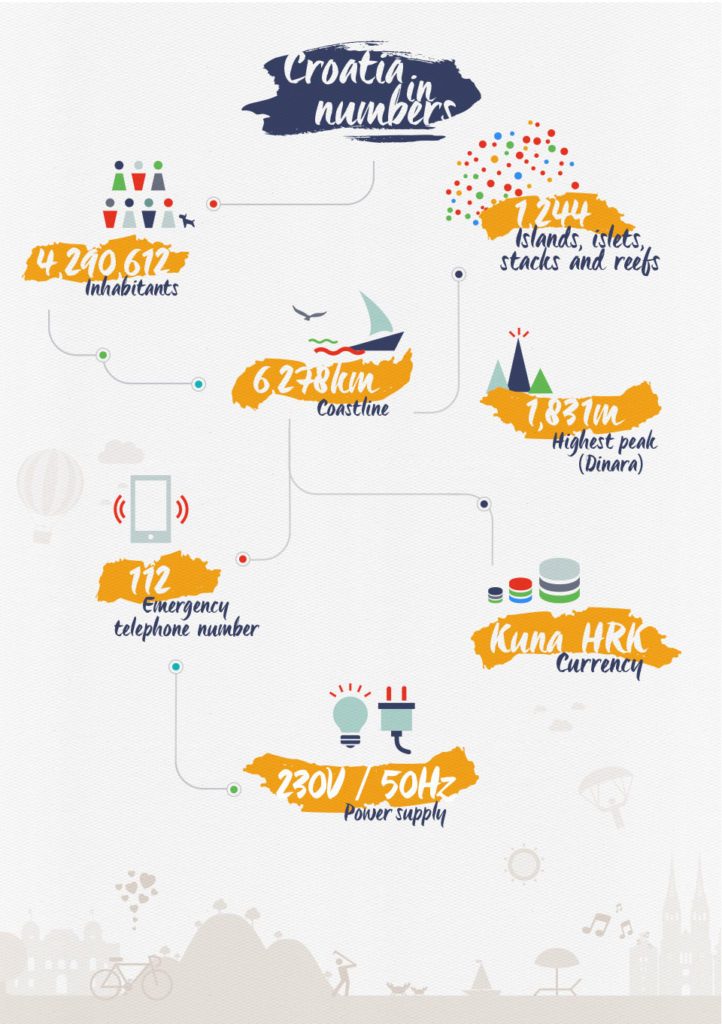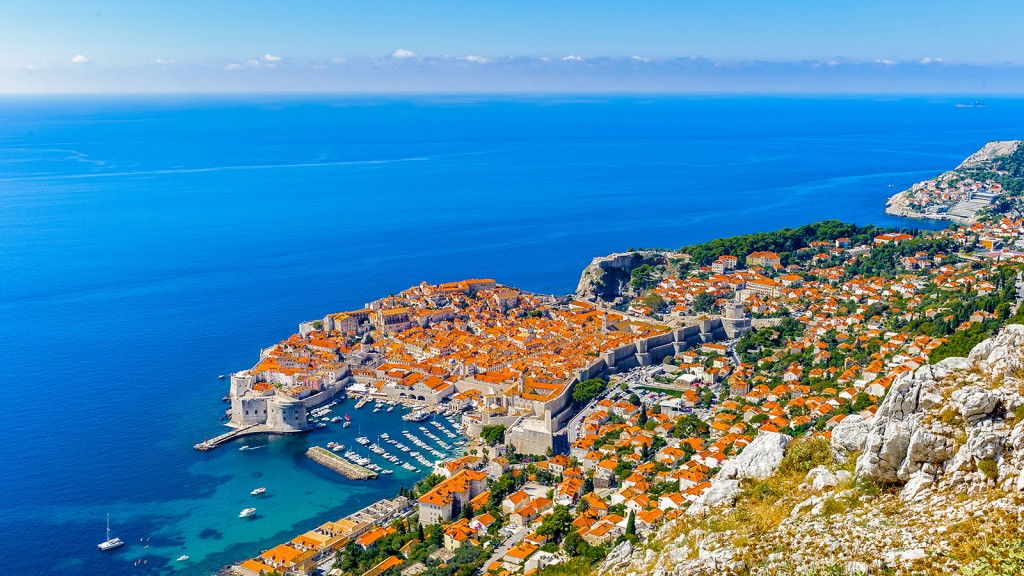Sailing in Croatia should be on your bucket list if you’re favorite pastime is spending time aboard. Croatia has a splendid coastline and some of the most fabulous islands in Europe. If this is your first Croatia holiday, this article is for you. Learn where, when and how you should be sailing in Croatia.
General Info
Croatia has 1246 islands, islets and inlets for you to sail. And only 47 islands are inhabited, which leaves you with plenty of islands for you to explore. You’ll fall in love with Croatia once you visit. If you sail here once, you’ll definitely come back.
Croatian currency is Kuna. There are 1, 2, 5, 10, 20, 50 Lipa coins, 1, 2, 5 and 25 Kuna coins and 10, 20, 50, 100, 200, 500 and 1,000 Kuna banknotes.
1 EUR is approximately 7.5 KN

When to go
If you’re planning a sailing holiday in Croatia, the best period to go there is from May to October. During this period the weather is warm, and the sun will keep you company. The sea temperature gradually rises, being at its best during July and August.
However, if you want to avoid the crowds, you might want to consider the month of September. By then, the number of tourists decreases considerably and so do the costs.
Sailing Itineraries
If you have a couple of days to spend in Croatia, our recommendation is to start your sailing itinerary from Split to Hvar or Trogir. During these tours, you’ll be able to see some of the most popular islands in Croatia. Moreover, you’ll have the chance to make a stop in Split and Dubrovnik, 2 major Croatian cities. Furthermore, the sailing distances between the island located on this route are not big, so you’ll have sufficient time to relax.
Some of the best Croatia sailing itineraries that will allow you to see the best parts of the Croatian seaside are:
Split → Trogir
One of the most recommended sailing trips in Croatia start from Split and ends in Togir. This tour can be carried out during a 7-days cruise as follows: day 1 Split – Milna (Brac), day 2 – Milna – Stari Grad (Hvar), day 3 – Stari Grad – Sv. Klement/Hvar, day 4 – Hvar, Scedro, Vela Luca (Korcula), day 5 – Vela Luka – Vis, day 6 – Vis – Trogir, day 7 – Trogir – Split.
Split → Hvar
Best Croatia yachting tours include a fabulous 13 days trip from Split to Hvar. The trip starts on day 1 when you depart from Split and reach Trogir, on day 2 – you get to Komiza, day 3 – Vela Luka (Korcula), day 4 – you see Lastovo, day 5 – Pomena (Mljet), day 6 – Sobra (Mljet), day 7 – Slano, day 8 – Dubrovnik, day 9 – Sipan, day 10 – Polace (Mljet), day 11 – Korcula, day 12 – Hvar. Finally, on day 13, you’ll turn back to Split.
Hvar → Komiza
Another great idea for a sailing holiday in Croatia is a 13-days tour from Hvar to Komiza. The destinations you can check out during this tour are Hvar →Pomena →Okuklje →Sobra →Dubrovnik → Cavtat →Sipan →Polace →Zaklopatica (Lastovo) →Vela Luka →Vis → Komiza.
7 day Sailing Itinerary. We recommend you a 7 day Sailing Itinerary in Croatia, from Split:
- Day 1 – Split to Brač
- Day 2 – Brač to Paklinski Otoci
- Day 3 – Paklinski Otoci & Hvar to Vis
- Day 4 – Vis to Lastovo
- Day 5 – Lastovo to Korcula
- Day 6 – Korčula to Makarska Riviera or Stari Grad
- Day 7- Makarska Riviera or Stari Grad to Split



Attractions you shouldn't miss
Maslinica – Solta Island
This little, but charming village is one of the most popular places on the island. Here, you can spend the night over in a luxurious hotel which used to be a castle. Moreover, the view of the sea at dusk and dawn is breathtaking.
Skardin – Krka Waterfalls
The Skardin Buk or the Roski Slap waterfalls located in the Krka Waterfalls National Park are a common attraction for those traveling to and from Split. Visiting the waterfalls will also allow you to see the genuine Croatian countryside. and some splendid lakes. A day trip is enough to indulge in all these.
Kornati National Park
The Kornati National Park is home to almost 150 spectacular islands and islets. Here you can embark on a memorable cruise and admire the cliffy scenery. Furthermore, the park is also blessed with numerous sandy beaches such as Lojena and historical attractions: Our Lady of Tarac Church or the Fort of Tureta.
Trogir
This ancient city is one of Croatia’s jewels, included in the UNESCO patrimony. It is highly praised for its Romanesque-Gothic influences, being the best example of its kind in Central Europe. Some of the landmarks you shouldn’t miss here include the Čipiko Palace, the Kamerlengo Fortress and the portal of Master Radovan.
Sali – Dugi Otok
The most renowned tourist destination on the island of Duci Otok is Sali, its administrative center. This place has a history that dates back thousands of years ago. Sali boasts an impressive number of historical and cultural attractions such as the Assumption of the Blessed Virgin Mary Church. Also, numerous festivals and events take place in Sali all year round.
Komiza – Vis Island
Komiza lies on the paradisiac island of Vis, in its largest bay. This tranquil location is a perfect holiday retreat if you seek relaxation. Narrow streets, traditional houses, fresh products, and beautiful beaches guarded by tamarix trees boost Komiza’s charm.
Marinas in Croatia
Some of the best marinas in Croatia where you can book a berth if you go on one of these tours are:
Located in Trogir, Split, this marina can accommodate 174 vessels of maximum 25 m. ACI Marina Trogir offers amenities such as laundry service, fuel, car park, internet, diving and sailing school, reception, restaurant and much more.
Located on the western part of the island of Brač, ACI Marina Milna offers safe shelter and modern amenities. It can offer 183 wet berths and 15 dry berths. The maximum length of the boats that can book a marina reservation here is 35 meters.
Korcula ACI Marina lies in the popular tourist destination of Korcula. It offers amenities such as master harbor, laundry, bar, restaurant, service station, fuel station etc. ACI Marina Korcula can accommodate 159 vessels of maximum 40 meters.
Marina Martinis Marchi is located on the island of Solta, near the elegant hotel bearing the same name that was initially a castle. The marina of Martinis Marchi can offer 50 moorings for boats of maximum 35 m in an exquisite environment.
ACI Marina Dubrovnik is one of the most popular marinas in Croatia, famous for its environmental approach. The ACI Marina Dubrovnik can accommodate 380 vessels of maximum 60 meters in a safe and picturesque setting.



Discover the best marinas in Croatia.
Boat tours in Croatia
If you want to explore Croatia by boat, there are countless operators that offer sailing trips in Croatia.
Every tour operator will propose a particular itinerary and service package. Everything can be organized in a timely manner so that you enjoy the full beauty of your Croatia sailing holiday.
The prices are usually affordable, and the tours may also include lunch and breakfast.
Rent a boat in Croatia
If you like to be more independent, you might want to rent a boat in order to visit Croatia. There are numerous options both as crewed charter and bareboat.
If you want to rent a bareboat, one of the members of your crew needs to have a certificate of boatman’s proof. Also, a radio certificate is normally necessary, but depending on the company you rent your boat from, you might get an exemption.
Winds in Croatia
Some of the winds that normally accompany sailors at sea as they cruise Croatia’s waters are:
Bura: a cold northern wind that blows from Norh-East to East-North-East. It is a dry and very strong wind that can give you quite a hard time if you are not an experienced sailor.
Cirocco: this warm wind typically comes from East-Soth, blowing in the South-Eastern direction. It is frequent in the South of the Adriatic Sea and it is a strong wind that brings rain.
Cyclonal Scirocco: the force of this wind varies from moderate to strong, reaching stormy magnitude at times. It moves from East-South-East to South East.
Anti-Cyclonal Scirocco: this wind is generally present during the spring or the autumn. It is usually accompanied by clouds and it blows from West-South-West. It can behave unpredictably and have a strong force.
Levant: this cold wind is typically accompanied by rains. This wind normally blows in the months of February and March.
Tramontana: this strong wind blows from North to North-West. This is a very sudden wind, arriving unexpectedly and turning into Bura.
Ponente: This westerly wind is usually felt in the northern part of the Adriatic Sea. It triggers long and high waves, creating harsh sailing conditions.
Libeccio: this is a South Western wind blowing to West-South-West, normally during the winter. The Libeccio can make the sea extremely rough.
Mistral: this thermal Adriatic wind usually starts blowing by the time the temperatures begin to rise. The Mistral’s force increases as it passes the Bay of Trieste and reaches the Otranto Strait, creating dangerous waves.
Burin: a thermal wind whose name was inspired by Bura, it blows in the same direction as the latter and doesn’t exceed 7 miles when it blows toward the sea.
Ostro: this moderate wind comes from the South. It is a thermal wind that anticipates the Maestral.
Tides and Lines in Croatia
There are no tidal differences that should concern you as you sail in Croatia. Moreover, strong currents are seldom present. The sailing season in Croatia is in the summer months when the weather conditions are great.
One of the winds to watch out for is the Bura. This wind is more frequent in winter, but can be felt in the other seasons as well.
Another wind you might meet in the summer is the Maestral. You will be able to keep up to date with the weather forecast in any harbor or by asking the welcoming locals for advice.
The typical berthing strategy in Croatia is deploying lazy lines. As you get closer to the marina where you have a marina reservation you normally get assistance. Most sailors prefer to moor heading backwards.
While you move closer to the port, you can throw the rope at the person assisting you so that they secure your boat.
Other tips
- Tap water is drinkable across all of Croatia
- Most of the restaurants take credit cards, but those without electricity maybe will be unable to charge your credit card so cash is he best solution
- Always check the price list in any restaurant before choosing fish. Croatian fish is well known and some types are expensive.
Sailing in Croatia can be the next best thing to do during the following months. If all we’ve said sounds good, we can’t wait to hear from you and help you book a berth in Croatia.

